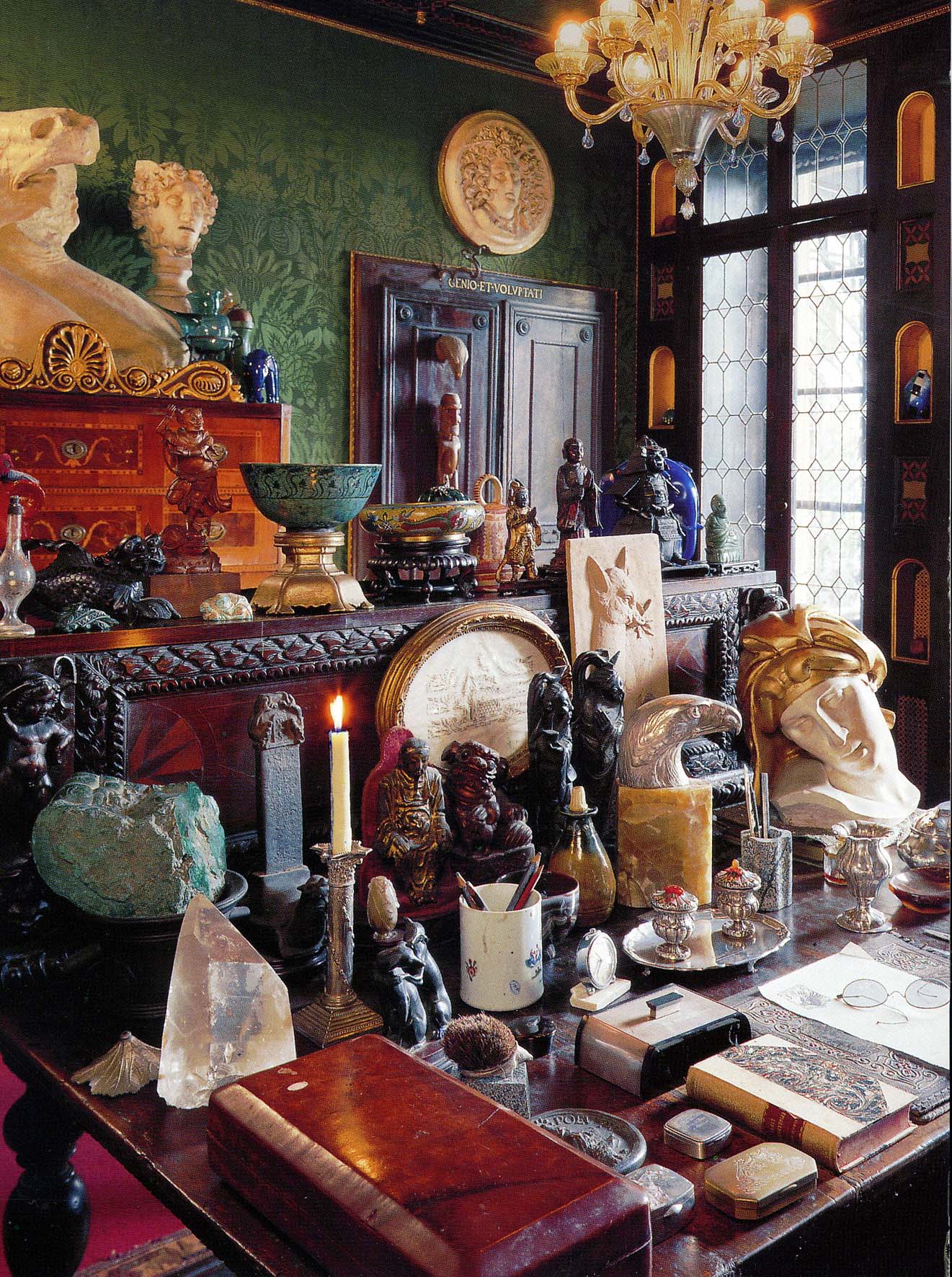
“Io ho quel che ho donato”
G. D’Annunzio
Year is just ended and a sense of nostalgia is pervading my days. During the lazy time between Christmas and New Year’s Eve I read “Infinite Variety”, about Marchesa Luisa Casati which lead me to read “Notturno”, an unusual book made of fragments that D’Annuzio wrote during his period of forced blindness. This, along with my growing interest in furnishing and decoration, reminded me when I visited the Vittoriale. I was just 12 but I can remember the sense of astonishment I felt looking around. This is a holy place for me, it means a lot as I’ve always been charmed by D’Annunzio’s Art.
Gabriele D’Annunzio is far beyond everybody and cannot be compared to anyone else. His house, the Vittoriale, where he spent the last days of his life, is a marvellous casket of treasures he hoarded during his lifetime. I dare not mention kitsch or bad taste to describe it, the Vittoriale is what remains of D’Annunzio aestheticism, the achievement of an assiduous and frantic research for beautiful and useless things (“tutte quelle cose inutili e belle che io amo con una passione profonda e rovinosa”) in order to cover the fear of emptiness.
The Vittoriale is located in Gardone Riviera, near Garda lake. So here are some pictures of the Priora, the house itself, room by room, but the Vittoriale includes also gardens, museums, a mausoleum, a theatre and other memorabilia.
ps: it’s very difficult to find Vittoriale’s photographs because it’s stupidly forbidden to take pictures inside. Almost all of these beautiful pics had been taken during the Fotografia Reflex day by this talented blogger. click for a bigger size.
sources: anto291.typepad.com; vittoriale.it
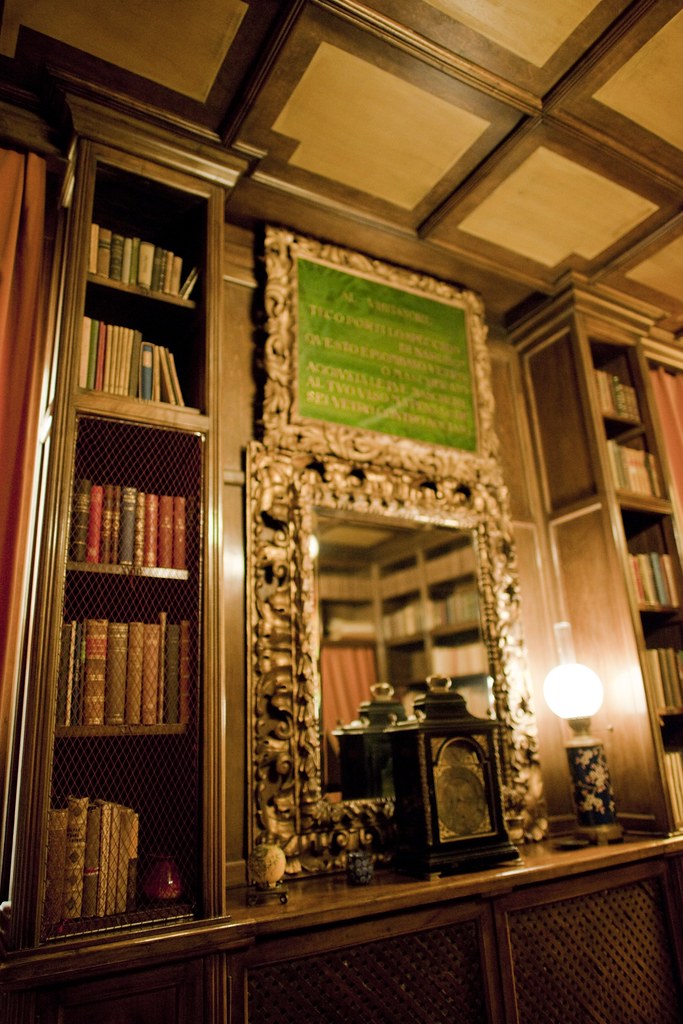
The Mask Maker Room (La Stanza del Mascheraio)
The name of room comes from the lines written above the mirror of the fireplace. They were written to mark Mussolini’s visit to the Vittoriale in 1925: This little room lined with shelves, contains about 900 volumes, music scores and a rich collection of records, a radio and a gramophone. The Venetian chandelier made of blown glass and gold mica (about 1923) the bronze horse made by Etling which had been exhibited at the Decorative Arts Exhibition in Paris in 1925, the lyre backed chairs by Gian Carlo Maroni and few deco pots made in Faenza by Melandri are also worth noticing.

The Music Room (Stanza della Musica)
It was first called after Gasparo da Salò, the first inventor of modern violin, but it was later renamed the counterpoint room. It is a large room dedicated to the pleasures of music and meditation. In order to improve the acoustics and meditation, its walls have been lined with precious black and golden damasks produced by the Milan firm Ferrari. It is insulated from outside noise by large, alabaster looking glass windows, made by Pietro Chiesa. In the room several music instruments can be found: two pianos, one clarinet, a small flute and a lute. On the walls there are a few paintings from the Thode collection: the painting of Cosima Liszt Wagner by von Lenbach and the death masks of Beethoven and Liszt. In the room there is a mixture of art deco objects (the hunting goddess Diana and Brozzi’s tondos), small oriental statues, Roman columns topped by multicolored and luminous pumpkins, fruit baskets made in Murano by Napoleone Martinuzzi, plaster casts of Greek sculptures and precious Persian peacocks. In this room D’Annunzio mean to express his syncretism in a unique expression of forms and symbols from cultures far apart.

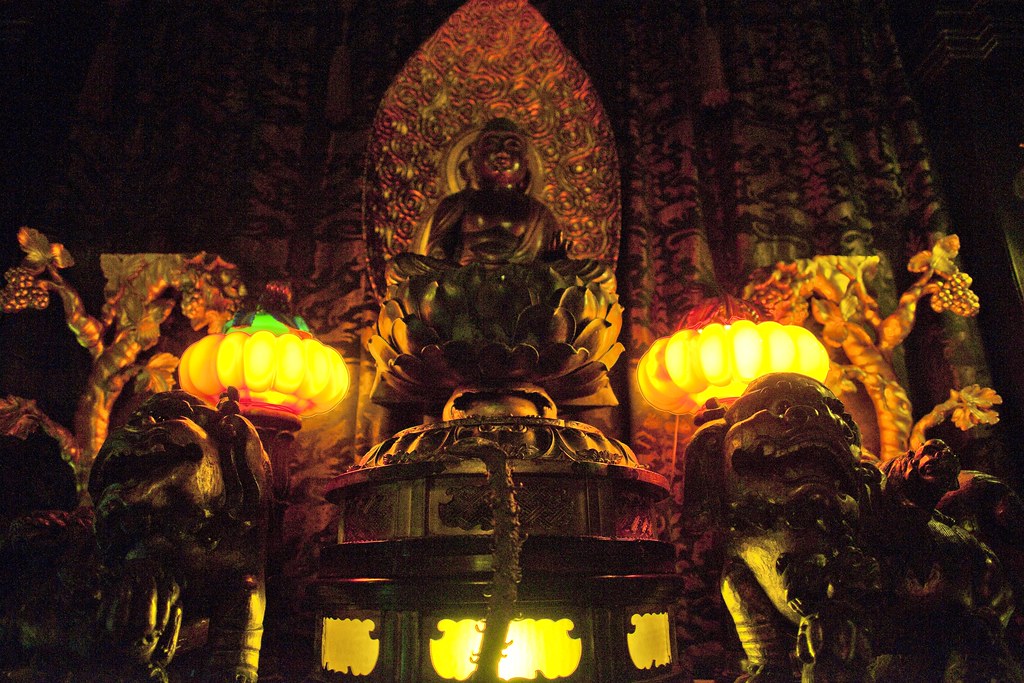
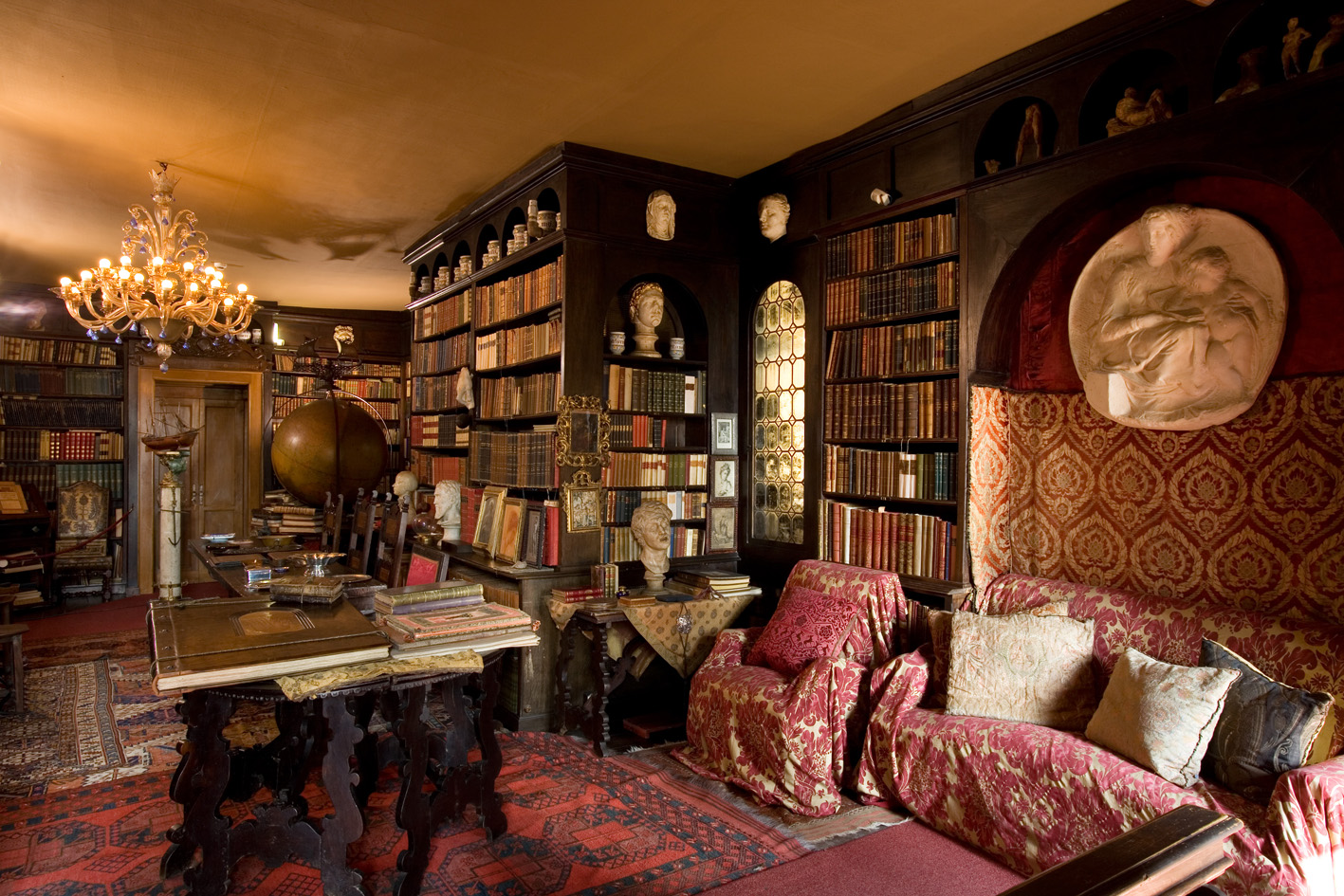
The Globe Room (La Stanza del mappamondo)
It is one of the large libraries in the Vittoriale and it takes its name from the large globe placed at the far end of the room. In this room one can notice the convent theme: the organ is decorated with little figurines representing the piagnoni (small statues which used to decorate French tombs int the XIV and XV centuries). Other decorative elements are: Napoleon’s funeral masque; Michelangelo’s plaster cast bust (the Poet used to think of him as the “Relative”) and the plaster cast of Pitti’s tondo. Finally, in a niche, one can find the Poet’s great inspirer: Dante Alighieri, here represented in a well known engraving by Adolfo de Carolis (1920) made at the time of Fiume and entitled “Dante Adriacus”. Over the architrave of the door opposite the organ, there is the motto: Aliquid amplius invenies in silvis quam in libris” (you will find something broader in the woods than in the books). Lining the walls there are about six thousands books, mainly History of Art. They had previously belonged to the art critic Henry Thode. On the table the precious edition of the Divina Commedia by Amos Nattini).



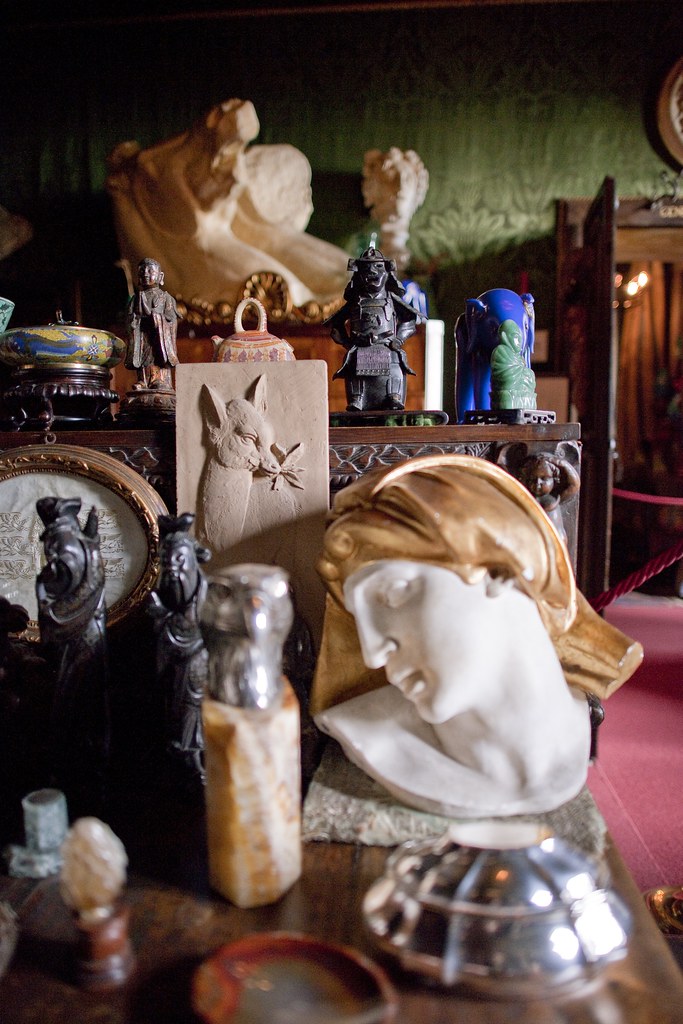
The Zambracca
The name comes from an ancient word used in Provence to mean “bedroom lady”. It used t be the Poet’s bureau where he used to read his post, but it was also used hall and dressing room (behind the desk, by the XVI century wardrobe, there is still a small niche with the Poet’s personal medicines). He used to spent most of his time in this private room, mainly in the last years of his life. Here Gabriele D’Annunzio died on the evening of 1st March 1938. Some objects lying on the desk are worthy of notice: the writing equipment by Mario Buccellati who had been the Vittoriale master goldsmith, called by the Poet “Mastro Paragon Cappella”, a silver eagle head by Renato Brozzi (1930), some exotic animals in Venetian glass, Michelangelo’s “Aurora” head, the plaster casts of the Parthenon horses by Fidia and a glass urn by Napoleone Martinuzzi (1925-26).
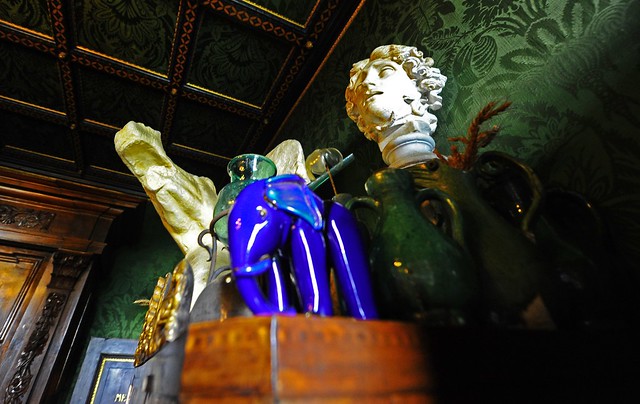
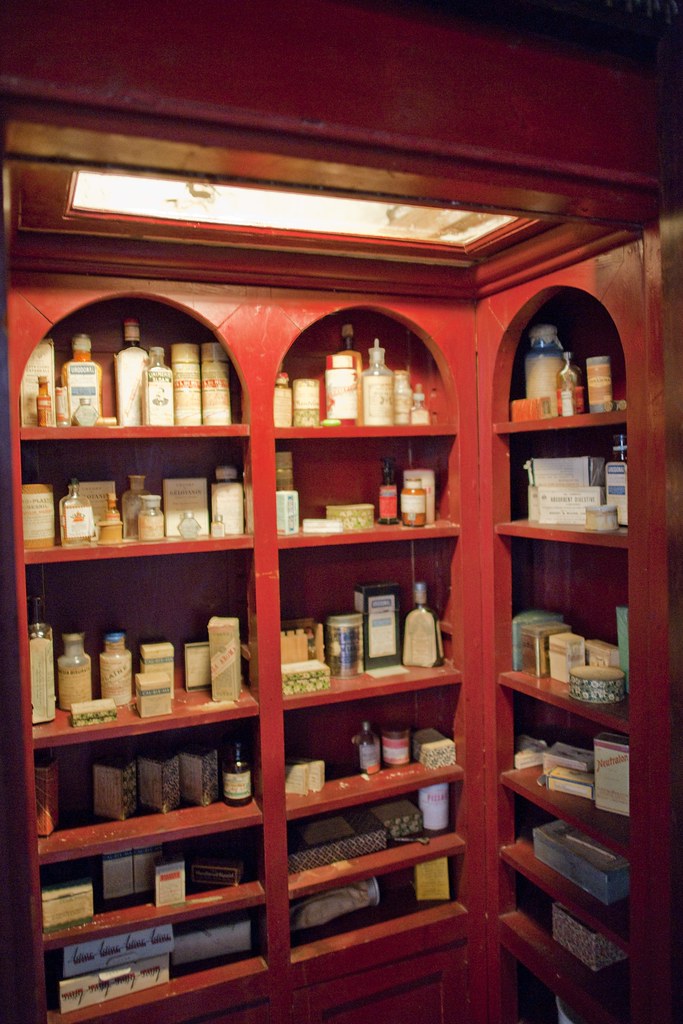
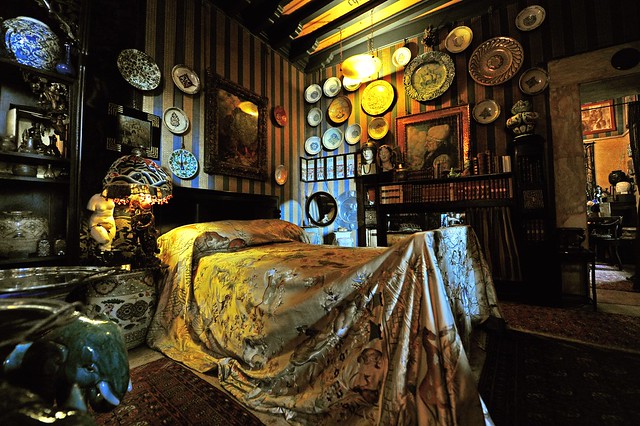
Leda’s Room (Stanza della Leda)
It used to be the Poet’s bedroom and its name comes from a large plaster cast placed on the mantelpiece portraying Leda loved by Jupiter who was turned into a swan. The deco fireplace is decorated with gilded niches and oriental statuettes made of Lalique glass. Over the door there is a motto “Genio et vuluptati” (genius and willpower) while near it an old title from Mantua Ducal palace saying “Per un dixir”. On the ceiling, decorated by Guido Murassing, one can read the famous verses by Dante Alighieri “three woman came to my heart…” The mixture of different objects is extraordinary: Chinese majolica elephants, Persian plates, Chinese bronzes, blue majolica and oriental furniture. The bedspread made of Persian silk, embroidered with wild animals (a gift from his wife) is beautiful, the portrait of the Doge’s wife by Astolfo de Maria and the large plaster cast of Michelangelo’s Dying Prisoner which D’Annunzio dressed up with bracelets, a precious silvery cloth around its waist, and a silver plaque by Martinuzzi portaying Apollo.
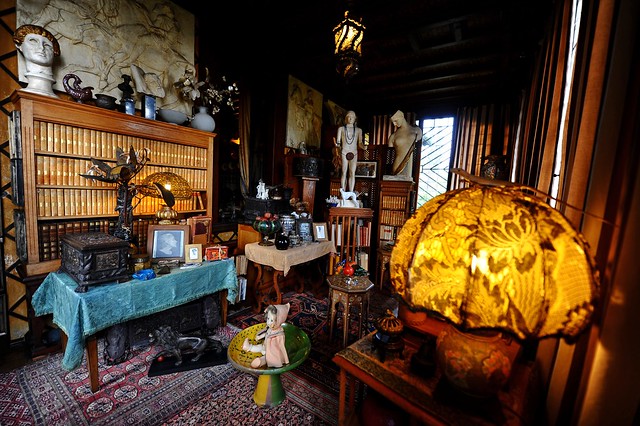
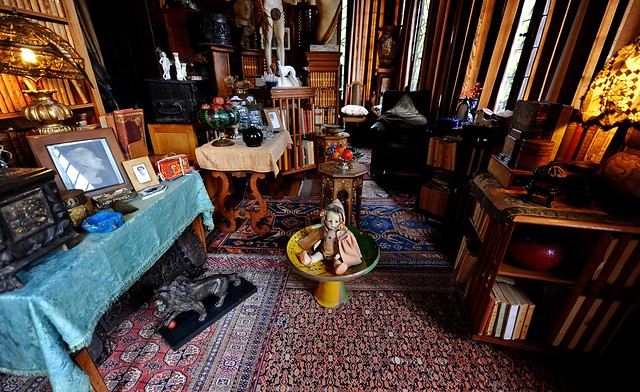

Apollino’s Veranda (Veranda dell’Apollino)
Maroni added this small room to the original structure of the villa in order to screen the direct sunlight from Leda’s room. It was a reading room overlooking the Vittoriale gardens, which sloped down towards the lake. Its name come from the plaster cast of an archaic Kouros decorated by the poet with blue eyes, a precious loin cloth and a sheaf of golden corn ears, symbol of fertility. The room is decorated with reproduction of of famous portraits of Italian renaissance painters, Lenci and Rosenthal porcelain animals, Persian carpets and vases. On a side table there are photographs of his mother and of Eleonora Duse.

The Blue Bath (Bagno Blu)
It was the master bathroom, a sort of precious casket where one can find more than 600 objects, which are mainly blue and green. On the ceiling there is Pindaro’s motto “Water is excellent”, on the walls there are reproductions of the “Ignudi” from Michelangelo’s Sistine Chapel. By the bathtub there is a rich collection of Persian ceramic tiles dating from XVII and XVIII centuries, together with multicolored ceramic and silver animals with precious stones from China. There is also an interesting block of malachite with a blown glass antelope by Guido Balsamo Stella, flanked by little Buddhas made of rock crystal. On the table various silver objects by Buccellati, Venetian glasses, collection of daggers, swords and fine piece of ceramic by Francesco Nonni made in 1927, which originally belonged to a larger group representing an oriental procession.
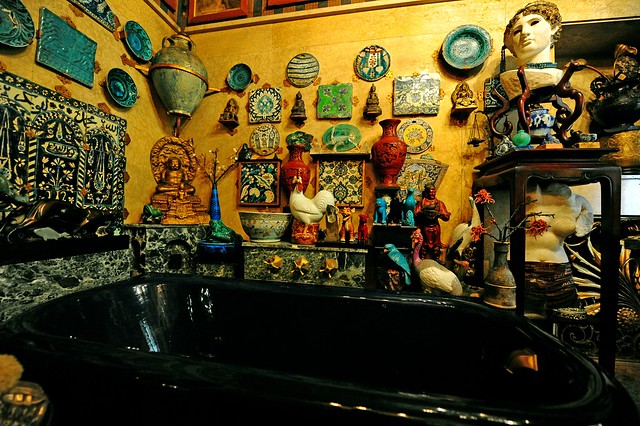


The Leper’s Room (Stanza del Lebroso)
It is also called the Pure Dreams Room. D’Annunzio thought to this room as his funeral room. It was added later to the main body of the house by Maroni and it’s full of symbols, more than the other rooms of the house. In his book “Le Faville del Maglio” (The Sparks of the Mallet) the Poet mentioned that five holy ladies had appeared to him in a dream inviting him to give up all worldly pleasures. To carry out his iconologic programme of this room D’Annunzio entrusted Guido Cadorin who, between 1924 and 1925 completed the decoration of the ceiling with five flying female figures: (Catherine of Siena, Judith of Poland, Elisabeth of Hungary, Odile of Alsace and Sybil of Flanders). The faces of the figures are however those of D’Annunzio’s women. The wardrobe panels are decorated with the Poet’s mottoes and deeds. Archangels decorate the alcove and the doors of the wardrobe. The figure of Christ blessing the Magdalen and,on the back wall there is Saint Francis embracing the leper which was meant to represent the Poet himself are also by Guido Cadorin. The walls are lined with buckskin, recalling the colour of the Franciscan habit, the symbols of the Passion of Christ are on the ceiling, the precious Saint Sebastian of the XVI century, the windows by Pietro Chiesa with inscriptions of Franciscan lauds: all this created the aesthetic myth so dear to the poet, who ask Moroni to built a bed in the shape of cradle-coffin where he could meditate on the mystery of life and death. His body was laid out in this bed during the night of 1st March and 2nd March 1938. On a table there are the phorographs of his sister Elvira, of his mother Luisa (on which there are some verses of the Paradise poem: Don’t cry anymore, your beloved son is coming back to you…) of Eleonora Duse, together with the Vestals’ cup in enamelled glass by Vittorio Zecchin 1919.
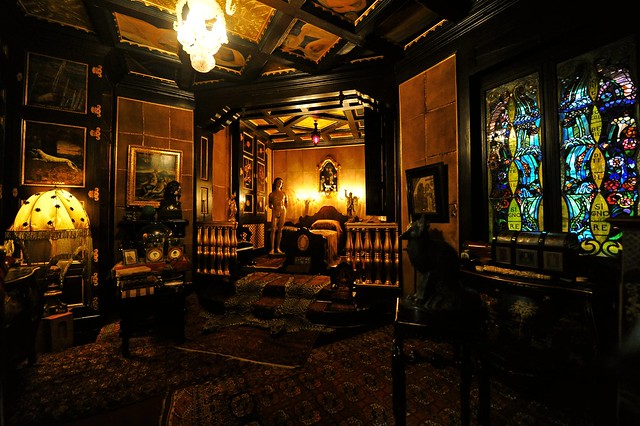
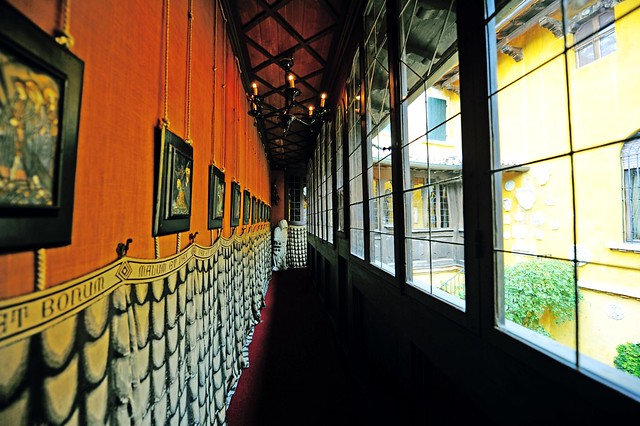
The via crucis corridor (Corridoio Via Crucis)
The corridor is so called because of the 14 enamelled copper tiles representing the stations of the cross, they are by Giuseppe Guidi. The walls are lined with materials produced in Milan by Lisio and Ferrari with the motto “Pax et bonum-malum et pax” (peace and good-evil and peace). Through the windows one can see the Slaves Yard, decorated with coats of arms, ancient fragments, sculptures (some of them are even Roman) and the Porch of the Relative, dedicated to Michelangelo with reproductions of some of his works.

The Relics Room (Stanza delle Reliquie)
Originally was called the cenacle because it was used as a dining room, being near the kitchens. In some hidden storage cabinets, crockery and silverware can still be found. Later it became a music room (The Counterpoint room) as indicated by the large window dedicated to Saint Cecilia (whose face is that of Luisa Baccara) made by Pietro Chiesa and Guido Cadorin, in 1925. In the Secret Book one can read: “Earlier, in the Relics Cenacle, among Saints and Idols, among the images of all creeds, and various aspect of the Divine, I felt overcame by the fullness of my religious synthesis…An infinite feeling of the religious longing from centuries and for centuries fill my lean breast”. The relics here gathered, are in fact partly his own relics (on the ceiling the flag from his Regency at Carnaro with the seven stars of the Great Bear). On a sort of altar there is the broken wheel of the boat where in 1930 Sir Henry Segrave died attempting the water speed world record, the bas-relief with Saint Mark’s lion given to him by the city of Genoa in memory for his speech for the “Garibaldi’s Mille” expedition celebrations in May 1915, the picture of Karussing hit by a grenade during the Bloody Christmas etc… and a few Christian and oriental relics (on the ceiling there is a group of wooden statues from the XIV to the XVIII centuries and the gilded XVI century altar with paper and silver charts of the XVIII century). On one side there is a pyramid of Indian, Chinese and Japanese statues, symbol of oriental religious, and on top there is a stutue of the Virgin Mary. At the entrance there are the Parthenon horses and Prassitele’s Hermes (his “androgyne shape” represents the absolute erotic ideal in the ninth section of Laus Vitae). The walls are lined with cloth embroidered with pomegranates by Mariano Fortuny and with a large biblical tapestry hanging from the beams, bearing the motto “Five are the finger, five are the sins (D’Annunzio used to exclude lust and lavishness from the seven capital sins).
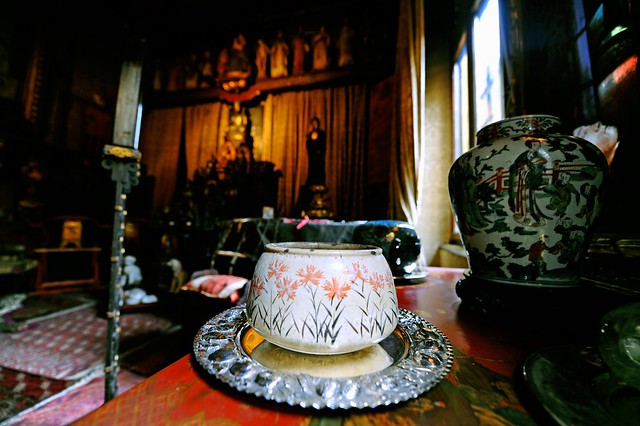
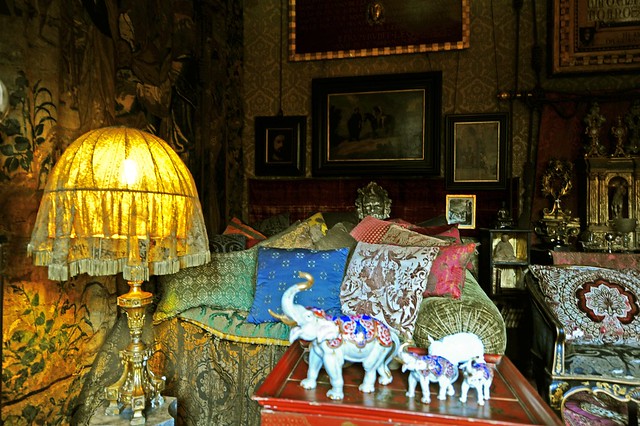

Dalmation Oratory (Oratorio Dalmata)
It was used as a waiting room for the few visitors admitted into the Prioria. On his XVI century stalls the seats of the prior, of the vice prior and the chancellor are clearly marked. Near the fireplace (designed by Maroni) a little Romanesque column supports a lion which came from the Dalmation town of Arbe. On the walls, religious pictures of various origins, including a Job after Ribera. In the middle of the room there is a very evocative collection of church objects (a ciborium, a censer and an aspergillia). From the centre of the ceiling hangs the propeller of the seaplane with which, in 1925, Francesco de Pinedo flew over 55,000 kilometers from Sesto Calende to Melbourne and then to Tokio.
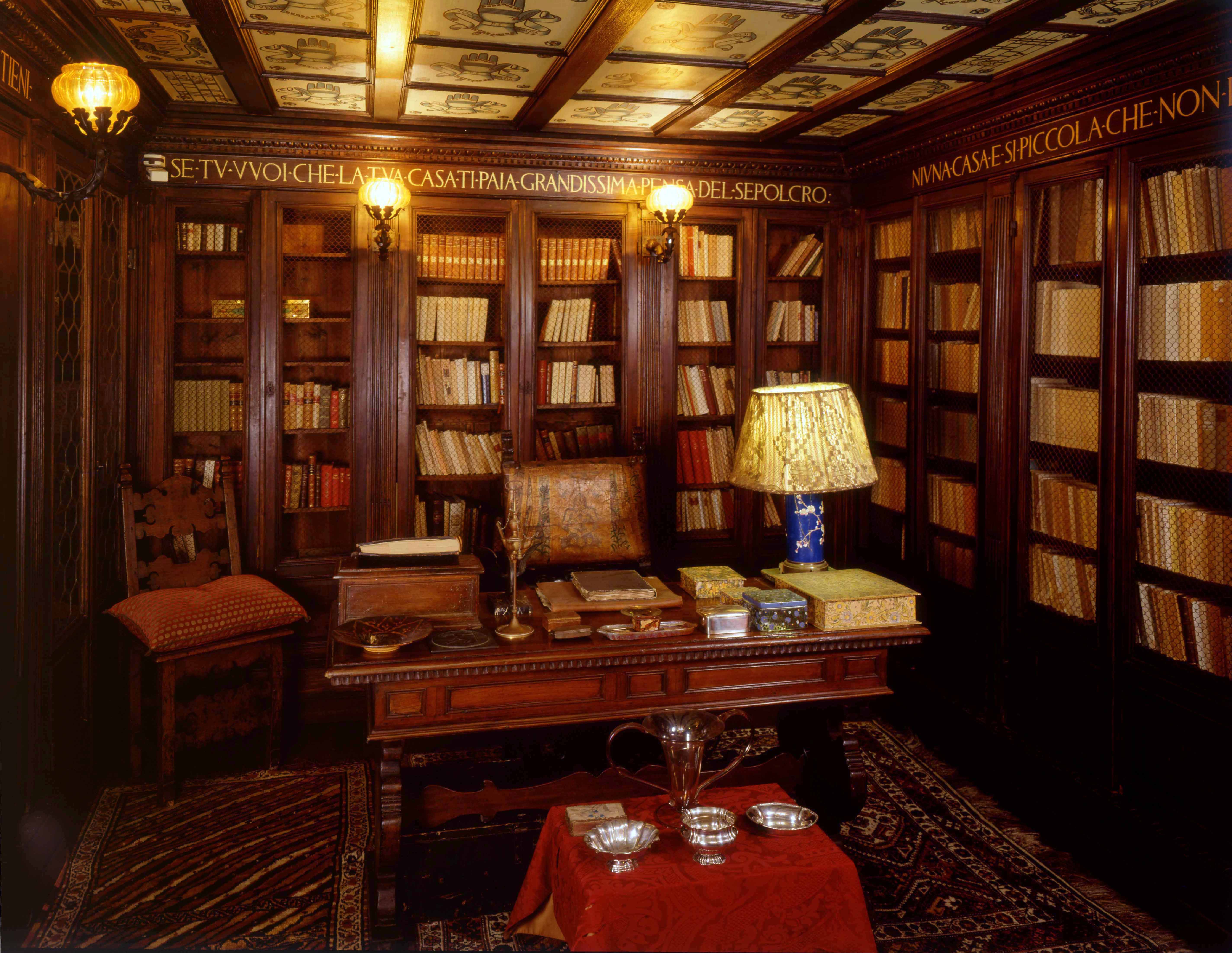
The One armed man room (Stanza del Monco)
Its name comes from a sculpture on the architrave of the door (a left hand severed and skinned) bearing a motto “Recisa quiescit” ( It rest after being severed). It was the room he used when dealing with correspondence. In fact since he couldn’t or wouldn’t replay to all the people who have been writing to him, he ironically declared himself armless, therefore unable to write. The wardrobe are the only pieces of furniture coming from the Capponcina, the famous villa near Florence, where the Poet lived between 1898 and 1910. On the shelves architrave there are four sentences by Leonardo da Vinci “the sky covers those who were never buried” “So that you can do more things that you can bear” “If you want your house to look very large, think of how small is the grave” “No home is small when dweller makes it look big”. Among the objects it is worth remembering the wooden writing box used by Gabriele during his school days at Collegio Cicognini in Prato and the dragonfly vase made in Murano and designed by Vittorio Zecchin (about 1914-1915).

The Office (Officina)
It is the only room in Prioria lit by natural sunlight and the only one to be furnished with simple and functional furniture made of clear oak. It was D’Annunzio study. One can approach it climbing three step and passing under a low architrave which makes the visitor bend down: as in respect of the art produced in there. The desks are arranged so that the Poet could consult, from his central position, a rich collection of words lists, vocabularies, special dictionaries, consultation books from which he could take words, phrases and old/modern linguistic solutions. In this room he used to work even sixteen hours a day, writing with goos father pens or metals pens on Fabriano paper. The water marks were designed by Marussing and De Carolis bearing the Poet’s mottoes. The room is also decorated with photographic reproduction of Michelangelo’s Sistine Chapel, of works by Mantegna, Botticelli, Raffaello and with plaster casts of the Partenon metopes, of various heads from Michelangelo’s sculptures and one of the Nike of Samothrace (the victory theme was dear to the Poet) and of Eleonora Duse’s face (from the marble prototype by Arrigo Minerbi, 1924) which the poet kept constantly veiled with a silk stole.
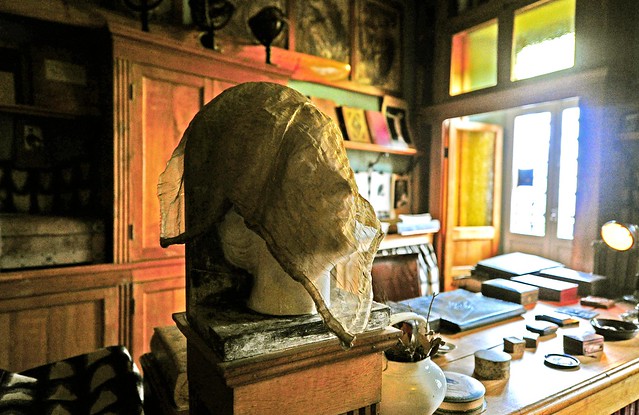
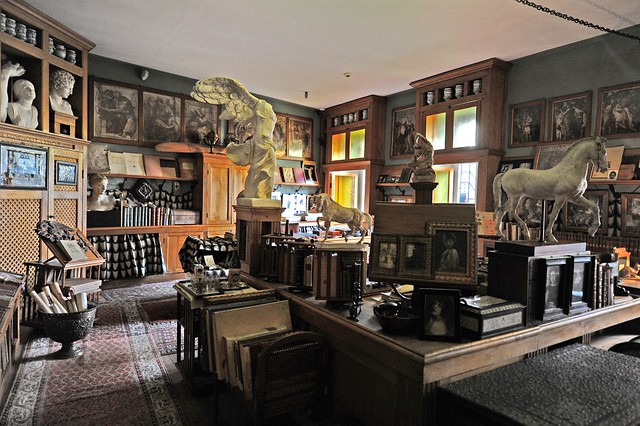
 here’s a invaluable detail. This is the portrait of Marchesa Luisa Casati by Man Ray, personally cutted by the Marchesa in order to look with a longer neck. It was gifted to D’Annunzio, as the dedication says: “A Ariel, Coré. La Figure de cire” (Ariel was the nickname the Marchesa gave to D’Annunzio and “La Figure de cire” was a novel-draft inspired by Luisa Casati that the Poet never finished.) picture credits: claudiarocchini
here’s a invaluable detail. This is the portrait of Marchesa Luisa Casati by Man Ray, personally cutted by the Marchesa in order to look with a longer neck. It was gifted to D’Annunzio, as the dedication says: “A Ariel, Coré. La Figure de cire” (Ariel was the nickname the Marchesa gave to D’Annunzio and “La Figure de cire” was a novel-draft inspired by Luisa Casati that the Poet never finished.) picture credits: claudiarocchini
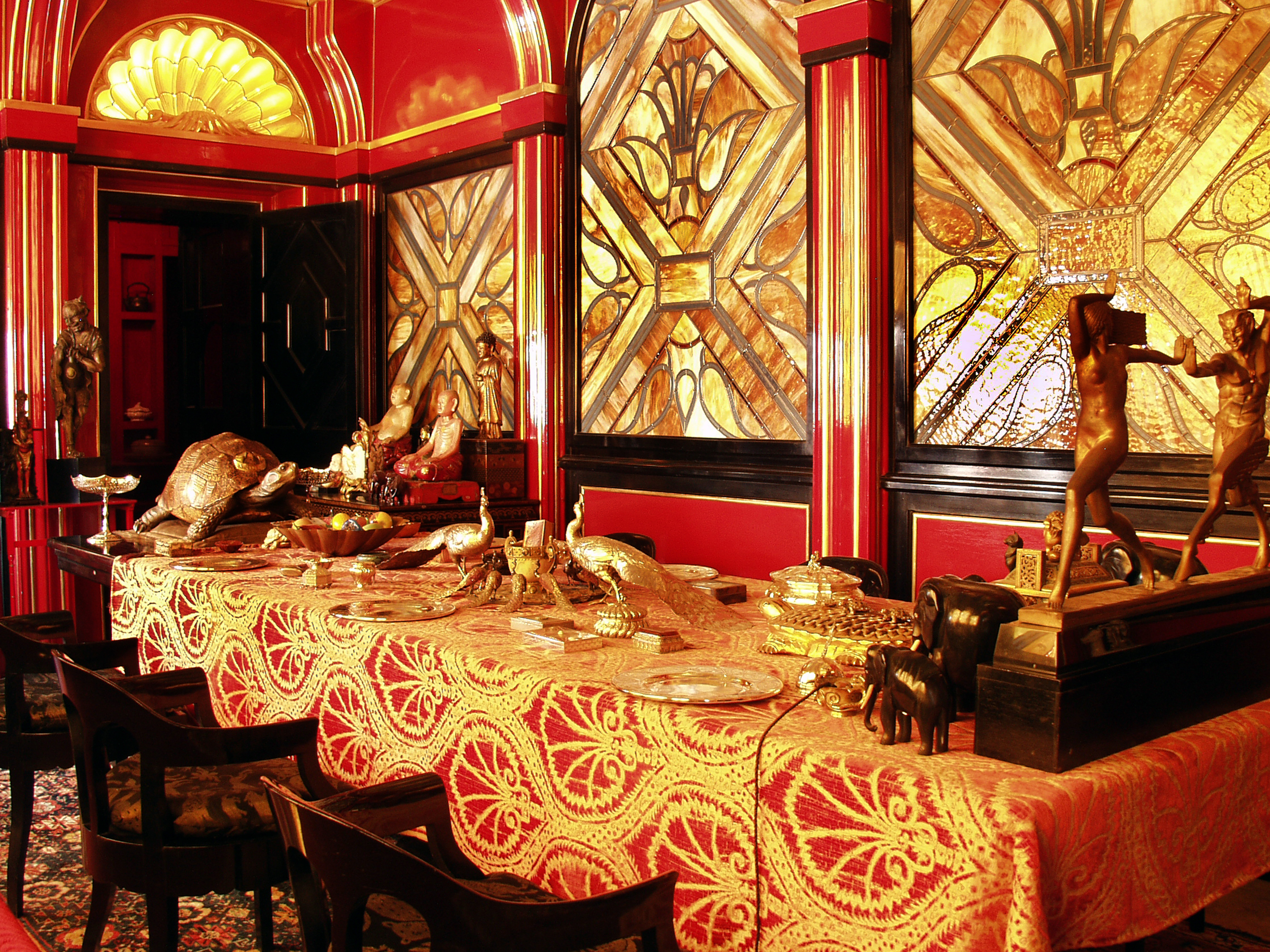
The Room of the Cheli (Stanza della Cheli)
It was finished in 1929. Its name comes from a large bronze tortoise given to the poet by Marchesa Luisa Casati who had died in the Vittoriale gardens after eating too many tuberoses. It used to be the guests’ dining room. During the last years of his life, d’Annunzio preferred to have his meals by himself in the Zambracca. The vivid colours: gold, blue and fiery red, and the windows (by Pietro Chiesa) looking like alabaster, make it the most deco room of the house. Infact it looks like the dining room of a cruise ship. The tortoise (from the greek khèlys) remind us of D’Annunzio in Laus Vitae, and it symbolizes the origin of poetry. In fact Apollo made a chithara from a tortoise shell. On the other side there is the bronze group of the Faun and the Nymph by Le Faguays, (interesting French deco) which reminf us of the enchanted images of the metamorphosis and of Alcyon’s divine and animal loves. The dining table is enriched by silver tortoises, pearls and precious stones, peacocks, glass fruits, silver tableware and beautiful silver plates with D’Annunzio mottoes by Renato Brozzi.
The Room of the Cheli is, according to the Poet, the only not sad room of the whole house.



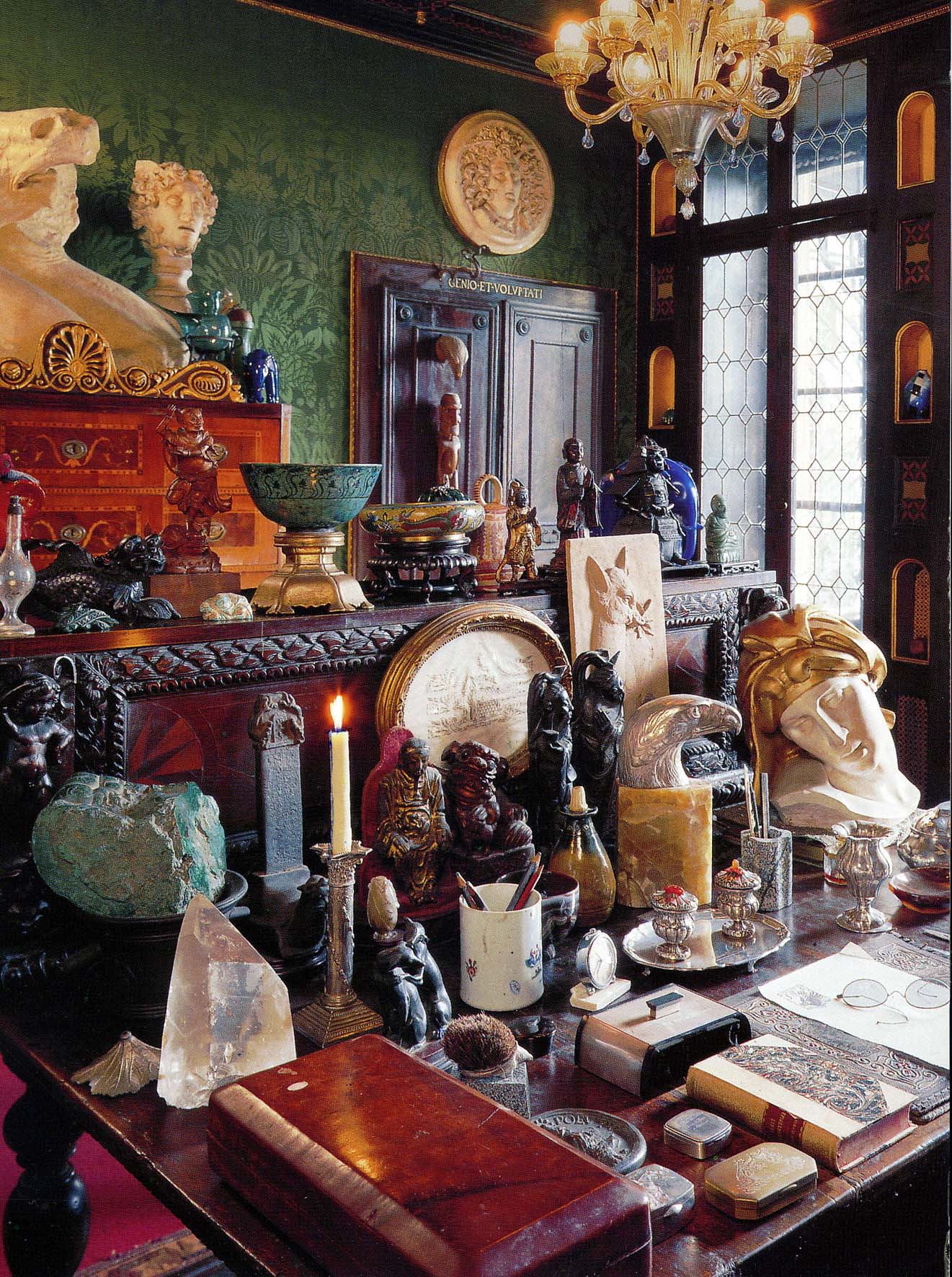
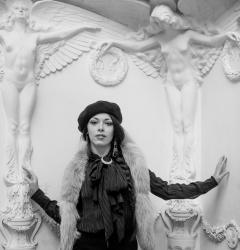


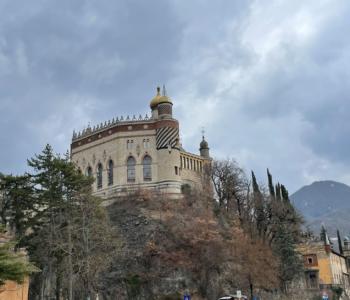
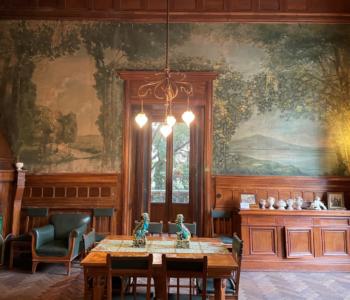
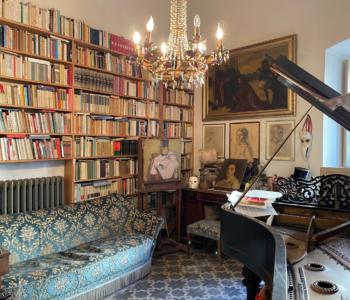
4 Commenti a “Il Vittoriale”
Ciao, posso chiederti se le foto le hai fatte tu personalmente o se le hai prese da altre fonti? Te lo chiedo perchè devo tornare al Vittoriale per fare un reportage per il mio Blog ma mi ricordo che qualche anno fa non era possibile per nessun motivo fare foto all’interno della casa. Grazie, ciao e complimenti per l’articolo perchè è molto bello e dettagliato.
Ciao, come ho scritto anche nell’articolo le foto sono state prese dal sito del Vittoriale e da questo blog: anto291.typepad.com che le ha scattate, da come lessi, durante una giornata dedicata alla fotografia reflex. Purtroppo infatti è vietato fare foto all’interno.
Ciao Annalisa,
Da molto tempo avevo letto il tuo articolo sul vittoriale e la casa-museo di D’Annunzio. Finalmente, sono andata il mese scorso a visitare questa bella casa che mi ha stupita ! Non vedevo l’ora di scoprire questo luogo del decadentismo italiano. Non sono stata delusa ! Era magnifico di poter vedere le stanze arredate con rafinatezza e anche la guardaroba di D’Anunzio. Grazie per consigliarci posti incredibili come questo.
Sylvia (sono la ragazza francese che ti aveva parlato della casa di Ernst Fuchs)
Cara Sylvia, sono davvero contenta che il Vittoriale ti sia piaciuto così tanto: è unico al mondo, imparagonabile a qualsiasi altro luogo.
Grazie per seguirmi!
Trackbacks per le News